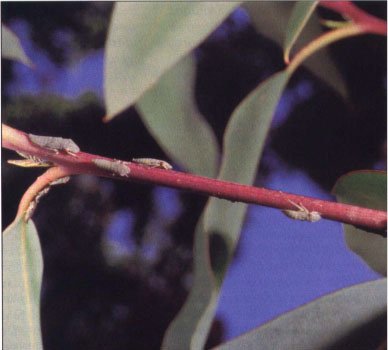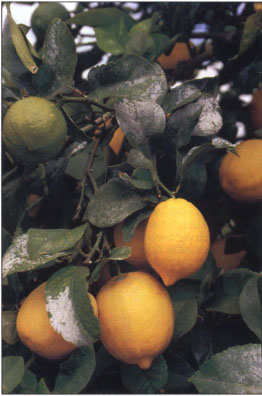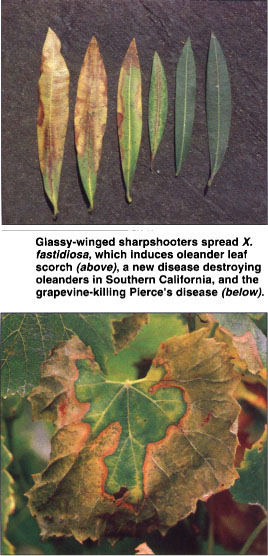All Issues
A new sharpshooter threatens both crops and ornamentals
Publication Information
California Agriculture 53(2):22-25. https://doi.org/10.3733/ca.v053n02p22
Published March 01, 1999
PDF | Citation | Permissions
Abstract
The glassy-winged sharpshooter (Homalodisca coagulata), an insect that has recently invaded California, and the smoke tree sharpshooter (Homalodisca lacerta) are creating serious new economic problems in both agricultural and ornamental plantings. The greatest threats surround their ability to spread the plant-pathogenic bacterium Xylella fastidiosa, which induces Pierce's disease in grapevines, almond leaf scorch disease, and a new disease known as oleander leaf scorch. Because of the potential distribution and large host range of the glassy-winged sharpshooter, other diseases caused by different strains of X. fastidiosa may have an even greater impact on the state's agricultural and ornamental landscape industries in the future.
Full text
Adult glassy-winged sharpshooters are brown to black with yellowish spots on their heads and are about 1/2-inch long. The smoke tree sharpshooter (facing left) is slightly smaller, and has wavy white lines on its head instead of spots.
A Southern Californian's introduction to the glassy-winged sharpshooter is usually initiated by “sharpshooter rain” — tiny droplets of liquid landing on one's head or face while sitting or standing under a sharpshooter-infested tree or arbor. Most people are horrified to note that these droplets are the excretions of a plant feeding insect. The glassy-winged sharpshooter (GWSS), likely introduced from the southeastern United States before 1990 as eggs on nursery stock, was first observed in Orange and Ventura counties (Sorensen and Gill 1996). Since then, the number of GWSS has continued to increase as it spreads throughout Southern California. This insect can now be found in high populations in areas of San Diego, Orange, Riverside, San Bernardino, Los Angeles, Ventura and Santa Barbara counties. This past summer, we have observed the GWSS for the first time in citrus orchards in southern Kern County.
Life cycle and biology
The glassy-winged sharpshooter, Homalodisca coagulata, is a large leaf-hopper, roughly 1/2-inch long, and generally brown to black when viewed from the side or above. The underside of the abdomen is whitish. The upper head and thorax are brown or black with numerous small ivory-to-yellowish spots (Nielson 1968). These spots distinguish the glassy-winged sharpshooter from its close local relative, the native smoke tree sharpshooter (Homalodisca lacerta), which has pale wavy lines instead of spots (Gill 1995). The smoke tree sharpshooter (STSS) is slightly smaller, and is distributed mainly in the drier areas of Southern California, from Riverside to the Coachella Valley.
Both sharpshooter species have a large host-plant range and are frequently found on citrus in western Riverside County. The host list of the GWSS includes 73 plant species in 35 families (Turner and Pollard 1959). We have noticed it reproducing on various crop plants in Southern California including citrus, avocado and grape. It also reproduces on ornamentals such as box wood, crape myrtle, philodendron, Chinese elm, ash, macadamia, birch, eucalyptus, hibiscus; and native or feral plants including laurel sumac, tree tobacco, sycamore and oak.
We have documented two generations of GWSS per year in Southern California. Oviposition occurs in late winter to early spring, and again in mid-to-late summer. In Ventura County, numbers of GWSS peaked in late spring at three sharpshooters per day on yellow sticky traps (10 inches by 3 inches), and again during July through August at eight per trap per day. At UC Riverside (western Riverside County), yellow sticky trap (9 inches x 7 inches) catches of adults ranged from a mean of less than 1 per day in December to a high of approximately 22 GWSS and 12 STSS individuals per day from July through August. Similar numbers of GWSS were trapped in Orange County, yet only a few STSS were trapped there. In Palm Desert (eastern Riverside County), yellow sticky trap (9 inches x 7 inches) catches of STSS peaked at 10 individuals per day in June, while only an occasional GWSS was found.
Adult GWSS live several months and lay small eggs side by side in groups of about 10, but ranging from one to as many as 27 (Turner and Pollard 1959). These sausage-shaped eggs are laid within host plants inside the epidermis of the lower leaf surface and appear as greenish blisters. The upper leaf surface above these blisters may be marked over time by a yellowish elongated blotch. After hatching in 1 to 2 weeks, the old egg blister appears as a tan to brown scar. On citrus, egg masses may be laid in fruit rind, making the fruit unmarketable. We are aware of one Ventura County grower who experienced an 8% decrease in pack-out of lemons due to rind injury. Nymphs feed on leaf petioles or small stems while they progress through four molts before becoming winged adults in 10 to 12 weeks (Turner and Pollard 1959). Less is known of the biology of the STSS, but it is likely similar to that of the GWSS.
We have observed natural enemies in California that specifically attack sharpshooters. One, a small egg parasite, Gonatocerus ashmeadi (Hymenoptera: Mymaridae) attacks the GWSS egg masses starting in the spring. Its activity increases through the summer to early October when as much as 80% to 95% of the eggs can be parasitized (Phillips 1998, Triapitsyn et al. 1998). Parasitized eggs are evident by the small circular hole left by the emerged parasite at one end of the egg. Related species that have been found in low numbers parasitizing GWSS eggs in California include G. capitatus, G. incomptus and G. novifasciatus (Triapitsyn et al. 1998). Other egg parasites have been identified from the natural range of the GWSS in Florida, Georgia and Louisiana (Triapitsyn et al. 1998). At UC Riverside, we observed a predatory wasp Pseneo kohlii (Hymenoptera: Pemphredonidae), which stings adult sharpshooters to disable them, then transports them to provision a burrow for a developing larva.
Problems associated with feeding
Sharpshooters feed on plants through strawlike mouthparts inserted into the xylem, tissue that conducts water throughout the plant. Because important nutrients are dilute in xylem fluid, the sharpshooters must process a large volume to meet their nutritional requirements (Mattson 1980, Anderson et al. 1989). In laboratory experiments, the hourly feeding rate of the GWSS exceeded 10 times its body weight (Anderson et al. 1989). Its sheer numbers in urban and suburban environments have caused it to become a nuisance in these communities. The large amounts of liquid excreted during feeding on trees in city parks and backyards make sitting beneath such trees a wet experience. Sidewalks and street edges may be wet during the early morning hours from sharpshooters feeding in the canopy of host trees growing above these surfaces. In infested citrus orchards, the tree canopies take on a white-washed appearance by mid-summer due to the buildup of residues after watery excreta evaporates day after day for several months. We observed that even after more than 25 inches of rain during the winter-spring of 1997-1998, these residues had not washed off of the leaves.
For both agricultural crops and ornamental plantings infested with large numbers of sharpshooters, irrigation management must be adjusted to meet the plant's greater need for water due to the copious amounts of fluid being removed by feeding sharpshooters. Although the large numbers of GWSS feeding in some citrus orchards would seem to reduce yield, studies have not been conducted to document this effect.
Spread of plant diseases
As xylem feeders, sharpshooters can be efficient vectors of bacterial plant pathogens that inhabit the xylem. The GWSS is well known for its capacity to spread the plant pathogenic bacterium Xylella fastidiosa. Different strains of this bacterium induce severe diseases in many agricultural and ornamental plants (Hopkins 1989). Once injected into the host plant's xylem tissues by a feeding sharpshooter, this bacterium multiplies and produces a gel-like material that in combination with the bacteria blocks water flow. This initially causes die-back of leaves and shoots distal to the point of infection, and may eventually cause the entire plant to die.
Glassy-winged sharpshooters spread X. fastidiosa, which induces oleander leaf scorch (above), a new disease destroying oleanders in Southern California, and the grapevine-killing Pierce's disease (below).
The best-known disease induced by X. fastidiosa is Pierce's disease of grapevine. It is the principal factor limiting the grape industry in the southeastern United States, where it is spread mainly by the GWSS (Adlerz and Hopkins 1979). In California, Pierce's disease is especially prevalent in the North Coast and to a lesser extent in the Central Coast, wine grape-growing areas where it is spread mainly by the blue-green sharpshooter (Graphocephala atropunctata). Because of the habitat preference of the blue-green sharpshooter, disease outbreaks are typically confined to the edge of a vineyard adjacent to riparian areas (Purcell 1975).
In 1997, the Pierce's disease bacterium was confirmed by laboratory-based assays in symptomatic grapevines from a vineyard in the Temecula area of Southern California (A. Purcell, personal communication), where major outbreaks of Pierce's disease were previously unknown. In 1998, our laboratory assays detected the Pierce's disease bacterium in more plants collected from throughout the Temecula area. Our efforts to trap or capture potential disease vectors during the spring and summer of 1998 have indicated that the GWSS is the most likely vector. In that time, besides many GWSS, only a few STSS were observed. No other sharpshooters were observed in semimonthly trapping and sweep-net capture efforts. The GWSS thrives in citrus, which frequently is adjacent to vineyards in Temecula. Moreover, Pierce's disease outbreaks in Temecula do not appear to conform to the typical “edge-effect” pattern of the disease in the north-coastal grape growing region (Purcell 1975).
The glassy-winged and smoke tree sharpshooters also are responsible for spreading a strain of X. fastidiosa that induces oleander leaf scorch, a new lethal disease of oleander (Purcell et al. 1999). The strain that induces oleander leaf scorch is distinctive and appears to be new to California on the basis of DNA analyses (A. Purcell, personal communication). Oleander leaf scorch was first noticed in the Palm Springs-Indio area of Riverside County in 1994 and is moving into adjacent areas. Since then, this disease has destroyed plantings of oleander at shopping centers, residences and freeway plantings in Orange County. More recently, oleander leaf scorch has been confirmed near the city of Riverside, in San Diego County, and in Arizona and Texas.
Potential for disease control
Several factors make it difficult to control diseases caused by X. fastidiosa. First, no cures are known for infected plants. Second, the sharpshooter vectors are extremely mobile, occur throughout the year in California and have a large host-plant range that includes many common ornamental and crop plants. Third, X. fastidiosa may infect a wide range of plant hosts without causing symptoms, and may cause diseases yet to be observed on other hosts. With the ease of international travel and illegal movement of plant and animal materials, it is likely new strains of X. fastidiosa will be introduced into California. These factors, and the complexity of a disease involving a three-way interaction among divergent organisms, complicates experimentation and inhibits quick solutions.
In general, the most effective control strategies for diseases that result from insect-vectored pathogens involve selecting or developing pathogentolerant or resistant cultivars. Because plant breeding is time consuming and expensive, surveying and screening appropriate cultivars for disease tolerance or resistance is a more reasonable first step. However, other methods are available to slow the spread of sharpshooters and X. fastidiosa until more effective long-term solutions are found. Such strategies may include ensuring that nursery stock is disease-free, using insecticides that interrupt the vector transmission or reduce vector numbers, and using cultural methods such as pruning that excise infected branches before the pathogen spreads throughout the plant.
Economic impact
Glassy-winged and smoke tree sharpshooters will have a substantial economic impact in Southern California by spreading plant diseases. Additional impacts they may have will depend on the growth over time of GWSS populations, their ability to spread to other areas, and whether or not other disease-inducing strains of X. fastidiosa are introduced. Although the smoke tree sharpshooter is native to Southern California, the exotic glassy-winged sharpshooter has a large potential to spread to other parts of California. The southern end of the San Joaquin Valley would seem to be especially susceptible because conditions there are similar to that of South-California, where abundant citrus and grapevines are similar to cropping patterns in Temecula and Santa Barbara.
In agriculture, a continual battle is waged against sharpshooters in the North Coast and Central Coast grape-growing regions where they spread the vine-killing Pierce's disease bacterium. Last year, members of the California grape industry rated Pierce's disease and leafhoppers, including sharpshooters, as the most important disease and insect problems, according to the American Vineyard Foundation. More than a century ago, before the urbanization of Orange County, Pierce's disease decimated an extensive grape industry, destroying about 40,000 acres of grapevines and closing 50 wineries (Gardner and Hewitt 1974).
Other concerns to growers involve the potential for the GWSS to vector strains of X. fastidiosa that induce diseases in other plants. In California, almond leaf scorch is a relatively minor problem that could become more important if the GWSS becomes established in the San Joaquin Valley. In its native areas, the GWSS is a well-known vector of strains of X. fastidiosa that induce phony peach disease and plum leaf scald (Raju et al. 1982, Wells et al. 1983). Of particular concern is the X. fastidiosa strain that induces citrus variegated chlorosis in South America, severely debilitating citrus orchards and eventually killing trees (Roistacher 1992). This disease is carried by several species of sharpshooters, which spread infestation from a few diseased trees in 1987 to more than 60 million trees by 1997. Because the GWSS and the STSS live on citrus throughout the year in California, spread of the citrus strain of X. fastidiosa could be rapid and devastating. As the GWSS spreads through citrus, the potential for such a disaster increases.
With regard to ornamental horticulture, an important part of the landscape in the Southwest will be lost if oleander leaf scorch continues to spread, and resistant oleander varieties are not found. This disease threatens to wipe out what is arguably the single most important shrub to California's landscape industry. Oleander is frequently overlooked and underappreciated because it is common and requires little care. Oleanders play important roles as ornamentals, windbreaks, borders, and roadside plantings. Oleander is found in 20% of all home gardens in California and is a mainstay of landscapes in shopping centers, parks, and golf courses. The California Department of Transportation (Caltrans) maintains oleander in over 2,100 miles of freeway median. Oleander is used similarly in other southwestern states, including Arizona, New Mexico, Nevada and Texas. Caltrans may suffer an estimated $52 million loss if oleanders in highway plantings are destroyed (Henry et al. 1997). In the city of Tustin (Orange County), approximately $200,000 was requisitioned to pay for removal of oleanders maintained on city greenbelts and for replanting other ornamental species. Other diseases induced by X. fastidiosa and spread by the GWSS in the southeastern United States affect elm, sycamore, oak and maple trees (Hopkins 1989).
Research to curtail the potential devastation of sharpshooter-spread diseases induced by X. fastidiosa is currently being conducted by UC at Riverside, Davis, and Berkeley, and at the county level through Cooperative Extension. Studies are under way to develop better methods for detecting X. fastidiosa and to examine means of reducing vector pressure in affected areas by managing pathogen and vector plant hosts. In addition, efforts will concentrate on short-term strategies to slow the spread of these diseases while long-term solutions are developed. Such short-term strategies may include the use of systemic insecticides that kill sharpshooters and disrupt transmission of X. fastidiosa by influencing the insects' feeding behavior.








